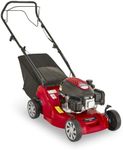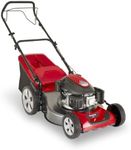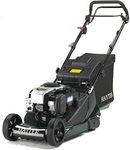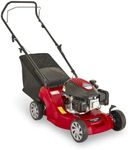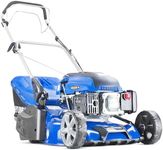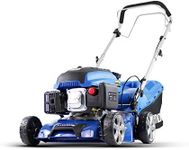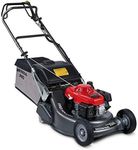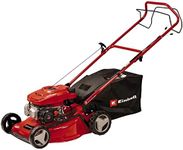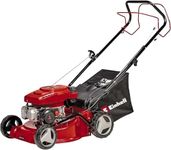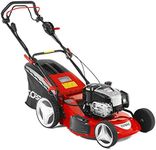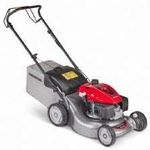Buying Guide for the Best Petrol Lawnmowers
Choosing the right petrol lawnmower involves understanding your lawn's specific needs and matching them with the features of the mower. Consider the size of your lawn, the type of grass, and the terrain. Petrol lawnmowers are powerful and suitable for larger lawns, but they require regular maintenance. Understanding the key specifications will help you make an informed decision that ensures efficiency and ease of use.Engine PowerEngine power in petrol lawnmowers is measured in cubic centimeters (cc) and indicates the strength of the mower. A more powerful engine can handle tougher grass and larger areas more efficiently. For small to medium lawns, an engine with 125cc to 150cc is usually sufficient. For larger lawns or tougher terrains, consider engines with 160cc or more. Choose based on the size of your lawn and the type of grass you have; more power is better for thick or wet grass.
Cutting WidthThe cutting width refers to the width of grass the mower can cut in a single pass. A wider cutting width means fewer passes to mow the lawn, which is ideal for larger areas. Cutting widths typically range from 16 inches to 22 inches. For small lawns, a narrower width is manageable and easier to maneuver. For larger lawns, a wider cutting width will save time and effort.
Cutting Height AdjustmentCutting height adjustment allows you to change the height at which the grass is cut. This is important for maintaining the health of your lawn, as different grass types and seasons require different cutting heights. Most mowers offer a range of settings, typically from 1 inch to 4 inches. Choose a mower with easy-to-adjust settings that suit the type of grass you have and the desired lawn appearance.
Self-Propelled vs. PushSelf-propelled mowers have a drive system that moves the mower forward, reducing the effort needed to mow. This is particularly useful for larger lawns or hilly terrains. Push mowers require manual effort to move and are suitable for smaller, flat lawns. Consider your physical ability and the size and slope of your lawn when deciding between these options.
Grass Collection OptionsGrass collection options include bagging, mulching, and side discharge. Bagging collects clippings for disposal, keeping the lawn tidy. Mulching cuts clippings into fine pieces that decompose and fertilize the lawn. Side discharge expels clippings to the side, which can be left to decompose or raked up. Choose based on your preference for lawn maintenance and the condition of your lawn.
Fuel Tank CapacityFuel tank capacity determines how long the mower can run before needing a refill. Larger tanks mean longer mowing sessions without interruption, which is beneficial for larger lawns. Capacities typically range from 0.5 liters to 1.5 liters. For small lawns, a smaller tank is sufficient, while larger lawns will benefit from a larger capacity to minimize refueling stops.
Weight and ManeuverabilityThe weight of the lawnmower affects how easy it is to maneuver, especially around obstacles and on slopes. Lighter mowers are easier to handle but may be less stable on uneven terrain. Heavier mowers provide more stability but require more effort to push or turn. Consider your physical strength and the layout of your lawn when choosing the weight of the mower.
